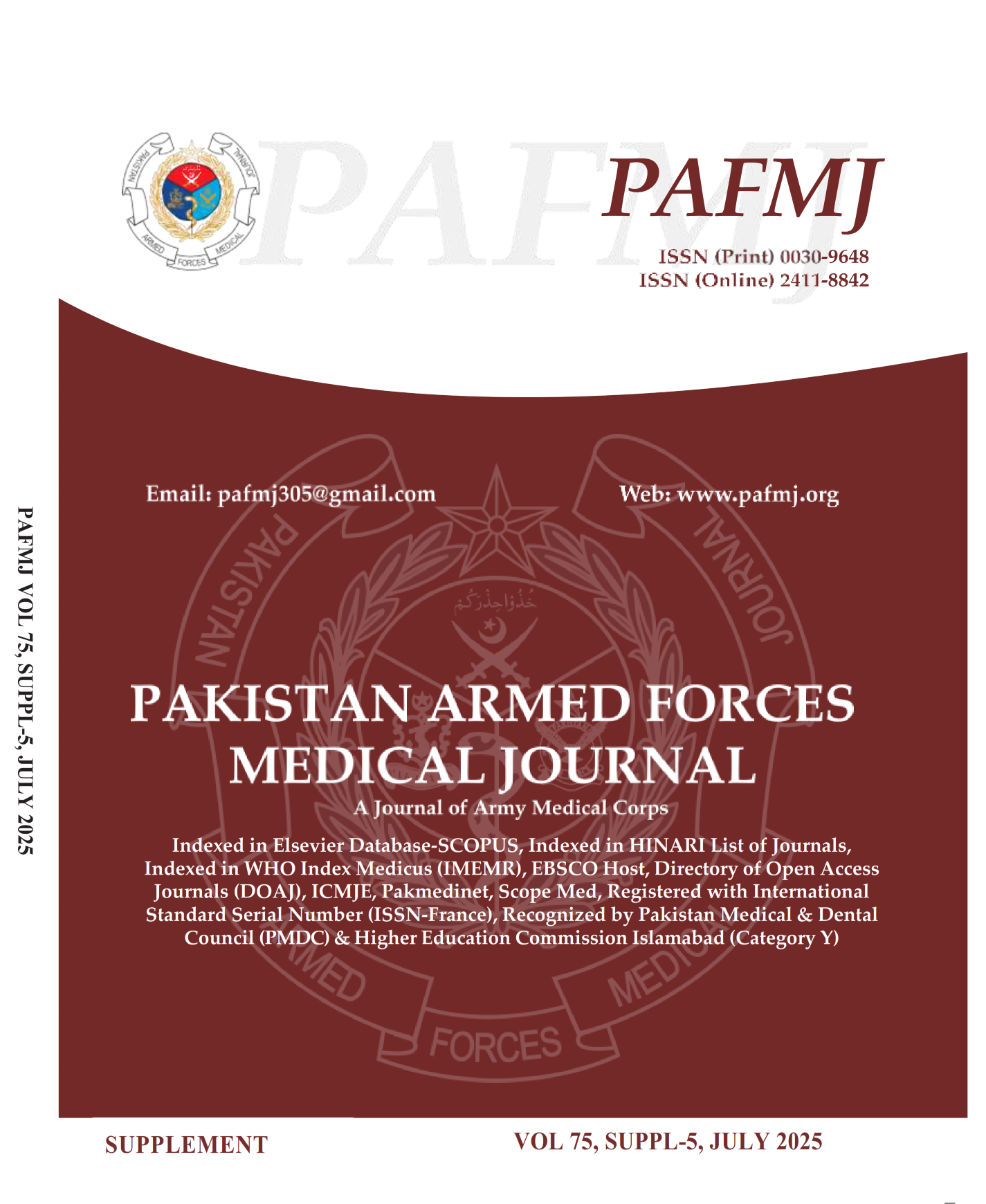Analysis of Factors Influencing Outcome of Depressed Skull Fracture in Pediatric Group
DOI:
https://doi.org/10.51253/pafmj.v75iSUPPL-5.8640Keywords:
Children, Depressed Skull Fracture, Outcome, Socio-Demographic Factors AnalysisAbstract
Objective: To look for outcome and analyze the factors influencing outcome of depressed skull fracture in pediatric group managed at tertiary care neuro-surgery unit
Study Design: Comparative Cross-sectional Study
Place and Duration of Study: Neurosurgery department Ayub Teaching Hospital Abbottabad Pakistan, from Jun 2021 to Apr 2022
Methodology: A prospective study was conducted on the pediatric patients managed for depressed skull fractures with any surgical intervention in our neurosurgery unit. Outcome was assessed at 72 hours by consultant neurosurgeon and classed as good outcome if discharged at 72 hours with GCS 15/15. Various sociodemographic and clinical variables were associated with presence of poor outcome among children included in the study
Results: A total of 100 children were included in the final analysis. Out of them 69(69%) were male while 31(31%) were females. Mean age of the study participants was 8.88±4.731 years. Eighty-six (86%) children with depressed skull fracture had good outcome after surgery while 14(14%) had poor outcome. Statistical analysis revealed that presence of compound fracture, dural tear and brain contusion was statistically significant association with poor outcome (p-value<0.05) in our study participants.
Conclusion: Outcome was good in most of the pediatric patients managed for depressed skull fractures in our study. Patients who had compound fractures, Dural tear or brain contusions at time of presentation were more at risk of having poor outcome in our study participants.
Downloads
References
1. Salman S, Saleem SG, Shaikh Q, Yaffee AQ. Epidemiology and outcomes of trauma patients at The Indus Hospital, Karachi, Pakistan, 2017 - 2018. Pak J Med Sci. 2020; 36(1): S9-S13. https://doi:10.12669/pjms.36.ICON-Suppl.1717
2. Hegde S, Bawa M, Kanojia RP, Mahajan JK, Menon P, Samujh R, et al. Pediatric Trauma: Management and Lessons Learned. J Indian Assoc Pediatr Surg. 2020; 25(3): 142-146.
https://doi: 10.4103/jiaps.JIAPS_35_19.
3. Garg K, Sharma R, Gupta D, Sinha S, Satyarthee GD, Agarwal D, et al. Outcome Predictors in Pediatric Head Trauma: A Study of Clinicoradiological Factors. J Pediatr Neurosci. 2017; 12(2): 149-153. https://doi: 10.4103/jpn.JPN_179_16.
4. Ortiz JB, Sukhina A, Balkan B, Harootunian G, Adelson PD, Lewis KS, et al. Epidemiology of Pediatric Traumatic Brain Injury and Hypothalamic-Pituitary Disorders in Arizona. Front Neurol. 2020; 10: 1410.
https://doi: 10.3389/fneur.2019.01410.
5. Bedry, Tuji, and Henok Tadele. “Pattern and Outcome of Pediatric Traumatic Brain Injury at Hawassa University Comprehensive Specialized Hospital, Southern Ethiopia: Observational Cross-Sectional Study.” Emergency medicine international vol. 2020 1965231. 29 Jan. 2020, doi:10.1155/2020/1965231
6. Yue JK, Upadhyayula PS, Avalos LN, Cage TA. Pediatric Traumatic Brain Injury in the United States: Rural-Urban Disparities and Considerations. Brain Sci. 2020; 10(3): 135. Published 2020. https//doi:10.3390/brainsci10030135
7. Hussein AA, Laeke T, Yohannes D. Clinical Outcomes and Prognostic Determinants of Surgically Treated Depressed Skull Fracture in Addis Ababa University Neurosurgical Teaching Hospitals: A Prospective Multicenter Observational Study. World Neurosurg. 2021: S1878-8750(21)01586-2.
https://doi: 10.1016/j.wneu.2021.10.089.
8. Lee SWY, Ming Y, Jain S, Chee SY, Teo K, Chou N, et al. Factors Predicting Outcomes in Surgically Treated Pediatric Traumatic Brain Injury. Asian J Neurosurg. 2019; 14(3): 737-743.
https://doi: 10.4103/ajns.AJNS_2_19.
9. Emami P, Czorlich P, Fritzsche FS, Westphal M, Rueger JM, Lefering R, et al. Impact of Glasgow Coma Scale score and pupil parameters on mortality rate and outcome in pediatric and adult severe traumatic brain injury: a retrospective, multicenter cohort study. J Neurosurg. 2017; 126(3): 760-767.
https://doi: 10.3171/2016.1.JNS152385.
10. Muhammad G, Javeed F, Rehman L, Abbas A, Afzal A. Pattern of Skull Fractures and Its Outcome in Pediatric Head Injury Patients. Pak J Neurol Surg. 2020; 24(4): 350-356.
11. Manne S, Musali SR, Gollapudi PR, Nandigama PK, Mohammed I, Butkuri N. Surgical Outcomes in Depressed Skull Fractures: An Institutional Experience. Asian J Neurosurg. 2019; 14(3): 815-820. https://doi: 10.4103/ajns.AJNS_111_19.
12. Arneitz C, Sinzig M, Fasching G. Diagnostic and Clinical Management of Skull Fractures in Children. J Clin Imaging Sci. 2016 Nov 16; 6: 47. https://doi: 10.4103/2156-7514.194261.
13. Satardey RS, Balasubramaniam S, Pandya JS, Mahey RC. Analysis of Factors Influencing Outcome of Depressed Fracture of Skull.Asian J Neurosurg. 2018; 13(2): 341-347. doi:10.4103/ajns.AJNS_117_16
14. Shao X, Wang Q, Shen J, Liu J, Chen S, Jiang X. Treatment of Traumatic Depressed Compound Skull Fractures. J Craniofac Surg. 2019; 30(7): 2239-2244.
https://doi: 10.1097/SCS.0000000000005982.
15. Spazzapan P, Krašovec K, Velnar T. Risk factors for bad outcome in pediatric epidural hematomas: a systemic review. Chin Neurosurg J. 2019; 5: 19. https://doi: 10.1186/s41016-019-0167-6.
16. Oktay K, Guzel E, Unal E, Yilmaz T, Okten AI, Guzel A. Outcome of Primary Bone Fragment Replacement in Pediatric Patients with Depressed Skull Fracture. Pediatr Neurosurg. 2019; 54(1): 28-35. https://doi: 10.1159/000495807.
17. Prakash A, Harsh V, Gupta U, Kumar J, Kumar A. Depressed Fractures of Skull: An Institutional Series of 453 Patients and Brief Review of Literature.Asian J Neurosurg. 2018; 13(2): 222-226. https://doi:10.4103/ajns.AJNS_168_16
18. Tariq M, Mian AM, Filza F, Ayub S, Khan SD, Jalal K. Outcome of patients operated for depressed skull fracture with dural tear. Pak J Neurol Surg. 2021; 5 (2): 126-133
Downloads
Published
Issue
Section
License
Copyright (c) 2025 Meena hayat, Abdul Aziz Khan, Zainab Manan, Naila Batool, Muhammad Wasim, Attiya Nasir

This work is licensed under a Creative Commons Attribution-NonCommercial 4.0 International License.















